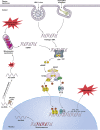Emerging Roles of cGAS-STING Signaling in Mediating Ocular Inflammation
- PMID: 37778330
- PMCID: PMC10616671
- DOI: 10.1159/000533897
Emerging Roles of cGAS-STING Signaling in Mediating Ocular Inflammation
Abstract
Cyclic GMP-AMP (cGAMP) synthase (cGAS), a sensor of cytosolic DNA, recognizes cytoplasmic nucleic acids to activate the innate immune responses via generation of the second messenger cGAMP and subsequent activation of the stimulator of interferon genes (STINGs). The cGAS-STING signaling has multiple immunologic and physiological functions in all human vital organs. It mediates protective innate immune defense against DNA-containing pathogen infection, confers intrinsic antitumor immunity via detecting tumor-derived DNA, and gives rise to autoimmune and inflammatory diseases upon aberrant activation by cytosolic leakage of self-genomic and mitochondrial DNA. Disruptions in these functions are associated with the pathophysiology of various immunologic and neurodegenerative diseases. Recent evidence indicates important roles of the cGAS-STING signaling in mediating inflammatory responses in ocular inflammatory and inflammation-associated diseases, such as keratitis, diabetic retinopathy, age-related macular degeneration, and uveitis. In this review, we summarize the recently emerging evidence of cGAS-STING signaling in mediating ocular inflammatory responses and affecting pathogenesis of these complex eye diseases. We attempt to provide insightful perspectives on future directions of investigating cGAS-STING signaling in ocular inflammation. Understanding how cGAS-STING signaling is modulated to mediate ocular inflammatory responses would allow future development of novel therapeutic strategies to treat ocular inflammation and autoimmunity.
Keywords: Age-related macular degeneration; Diabetic retinopathy; Keratitis; Ocular inflammation; Uveitis; cGAS-STING signaling.
© 2023 The Author(s). Published by S. Karger AG, Basel.
Conflict of interest statement
The authors have no conflicts of interest to declare.
Figures


References
Publication types
MeSH terms
Substances
LinkOut - more resources
Full Text Sources
Research Materials

